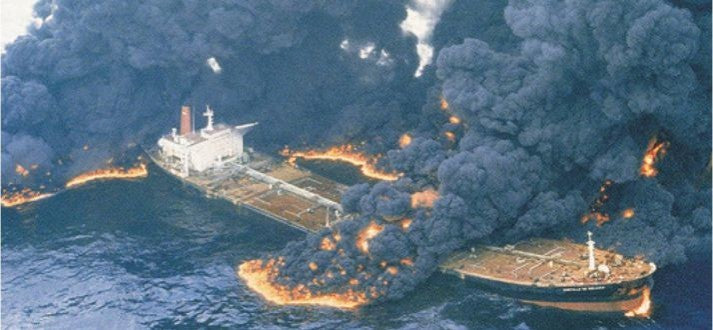The Castillo de Bellver Oil Spill: A Tragedy That Redefined Oil Spill Response
Ashton Routhier
Share
On August 6, 1983, the Spanish supertanker Castillo de Bellver caught fire off the coast of South Africa, setting into motion one of the most alarming maritime environmental disasters of the 20th century. Carrying 250,000 tonnes of light crude oil, the tanker exploded and eventually split in two near Table Bay, releasing an estimated 145,000 to 170,000 tonnes of crude oil into the sea.
As the vessel burned and broke apart 70 miles northwest of Cape Town, a 20-mile-long slick of flaming oil trailed across the water. Winds pushed the fire-torn bow of the ship dangerously close to shore, threatening marine sanctuaries, fisheries, and farmland. Black smoke rose a thousand feet into the air, visible from miles inland.
Three crew members were never found. And while the full ecological toll was not immediately measurable, the event sent a powerful message to governments, environmental agencies, and industry: large-scale marine disasters could happen anywhere, at any time.
A Fragile Coastline on the Brink
The Castillo de Bellver spill occurred near an area known for its seabird rookeries and commercial fishing grounds, including the Langebaan Lagoon—a protected marine sanctuary. Half of South Africa’s lobster and fish landings are caught within the impacted region, making this one of the most economically and biologically significant zones along the country’s coast.
In the early hours following the fire, officials feared that the oil would wash ashore, devastating ecosystems and polluting critical fishing waters. The risk to wildlife was immediate: approximately 1,500 gannets were oiled on nearby islands just ahead of their breeding season, and there were concerns over the impact of dispersants on local seal populations. Inland, “black rain” from airborne oil droplets fell on wheat-growing and sheep-grazing fields.
The stern section of the vessel, still loaded with an estimated 100,000 tonnes of oil, capsized and sank in deep water. The bow, drifting dangerously toward the coast, was later sunk with explosives to avoid additional contamination.
Environmental Consequences: Seen and Unseen
Remarkably, the worst-case scenario—thousands of barrels of oil washing ashore—was avoided. A shift in wind direction pushed the oil slick offshore, where it was absorbed into the Benguela Current and carried away from the South African coastline.
Dispersants were sprayed along the slick’s edges, preventing it from advancing within 32 kilometers of the shore. In total, over 61,000 gallons of diluted chemical dispersants and additional concentrate were used during the response.
While the visible shoreline damage was minimal, the full ecological impact is still debated. Beyond the visibly oiled birds, the spill prompted serious concern over:
- Long-term contamination of marine sediments
- Bioaccumulation in fish and shellfish
- Disruption of breeding cycles in seabird populations
- Secondary effects on coastal agricultural land
The spill served as a stark example of how a single vessel failure—no matter how far from shore—can threaten entire ecosystems and economies.
Building Smarter Response Strategies
The Castillo de Bellver incident reshaped how South Africa and much of the world thought about oil spill response. At the time, dispersants were a first line of defense—but they came with environmental trade-offs. Today, the preference is increasingly shifting toward mechanical and sorbent-based response systems that are fast, non-toxic, and environmentally neutral.
This evolution in response strategy is what led to the development of products like Pristine Sea™.
Pristine Sea™: Designed for First Response on Water
Pristine Sea™, distributed by STW Enviro and manufactured by FluidTech, was developed as a non-toxic, rapid-deployment oil spill sorbent. Built with the lessons of past disasters in mind, including Castillo de Bellver, Pristine Sea™ is engineered to float atop freshwater, saltwater, or brackish water and quickly encapsulate oil, fuel, or solvent spills.
Unlike chemical dispersants, which often trade one environmental hazard for another, Pristine Sea™ allows responders to physically recover the oil, minimizing long-term ecological impact. It clumps into manageable, buoyant masses that are easy to recover and dispose of safely.
Its use cases include:
- Emergency response at coastal terminals and refueling stations
- Offshore platforms and vessels
- Spill response around ports, marinas, and shipyards
- Inland bodies of water near highways, pipelines, or storage tanks
Whether deployed in small tactical bags or large-scale super sacks, Pristine Sea™ helps responders act within minutes—not hours.
Prevention Is No Longer Optional
The Castillo de Bellver oil spill could have had far greater consequences. Nature’s timing spared the coast from lasting damage. But relying on wind direction is not a strategy.
Today, responsible operators must plan not only for compliance—but for impact mitigation. Public awareness, investor scrutiny, and government oversight are more intense than ever before. The question is no longer if you need a spill response plan—but how effective your plan really is.
Pristine Sea™ provides the tactical, non-toxic, and fast-acting response option that modern operations demand.
Looking Forward
The oil spill that occurred off the coast of South Africa more than 40 years ago is a reminder that environmental responsibility cannot be an afterthought. It must be built into the tools we use and the strategies we design.
At STW Enviro, our mission is to connect public agencies, private operators, and industrial leaders with the solutions that allow them to act decisively and responsibly—before a crisis becomes a catastrophe.
Interested in learning more about Pristine Sea™?
Contact STW Enviro today to request technical specifications, pricing, or a response plan consultation tailored to your operational risk profile.
